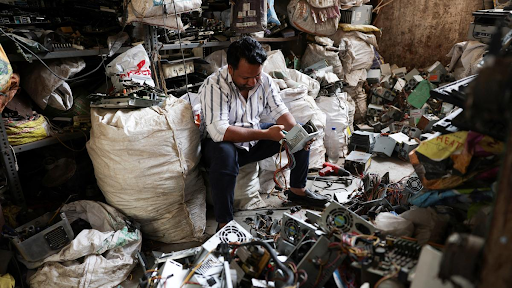



India must revamp e-waste management by enforcing EPR rules, introducing floor pricing to support formal recyclers, integrating informal workers, and investing in infrastructure. Promoting consumer awareness, sustainable product design, and digital tracking will ensure environmental safety, recover valuable materials, and align India with global sustainability and trade standards.

Copyright infringement not intended
Picture Courtesy: THE HINDU
India must urgently transform e-waste management with structured pricing, formal recycling, and sustainability reforms.
E-waste refers to discarded electronic devices like smartphones, laptops, TVs, refrigerators, and medical equipment. These devices contain valuable materials like gold, copper, and rare earth metals but also hazardous substances like lead, mercury, and cadmium.
If not handled properly, e-waste pollutes water, soil, and air, harms human health, and wastes resources.
In India, e-waste volumes increased by 151.03% in six years, from 7,08,445 metric tonnes in 2017-18 to 17,78,400 metric tonnes in 2023-24, growing by 1,69,283 metric tonnes annually.
Improper e-waste management causes severe damage.
India loses ₹80,000 crore yearly in critical metal value (e.g., gold, copper) due to inefficient extraction and loses $20 billion in tax revenue because informal recycling is cash-based and untaxed.
It is a policy that ensures companies (producers, importers, and brand owners) handle the environmental impact of their products throughout their lifecycle—from design to disposal.
It promotes a circular economy, where materials are reused, reducing the need for new resources and minimizing landfill use.
In India, the E-Waste (Management) Rules, 2022 enforce EPR by requiring producers to meet recycling targets through registered recyclers. They must obtain EPR certificates to prove compliance.
The floor price is the minimum amount recyclers receive for processing e-waste. This provision was introduced in the E-Waste (Management) Rules, 2022, to curb informal recycling, which dominates 95% of the sector and uses hazardous methods.
Encourages Formal Recycling => Stable pricing motivates registered recyclers to adopt advanced, safe technologies. This helps recover valuable materials like gold and copper efficiently, reducing waste.
Reduces Environmental Harm => Fair pay encourages recyclers to prioritize material recovery over dumping, preventing toxins like lead and mercury from polluting soil and water.
Levels the Playing Field => Informal recyclers have a cost advantage because they ignore safety and environmental standards. A floor price makes formal recycling financially viable, encouraging compliance.
Supports a Circular Economy => By turning e-waste into a resource, floor pricing aligns with sustainability goals, creating jobs and reducing resource scarcity.
Ensures Market Stability => Without a floor price, certificate prices could crash, starving recyclers of funds and making it harder for producers to meet EPR targets.
Strengthen EPR Implementation => Enforce the E-Waste (Management) Rules, 2022 strictly, ensuring producers meet recycling targets and use registered recyclers.
Formalize the Informal Sector => Integrate informal workers into formal systems through training, licensing, and cooperatives, to protect livelihoods while improving safety.
Invest in Infrastructure => Build advanced recycling facilities to handle e-waste volumes. Fair pricing will attract investment, unlocking e-waste’s economic potential.
Raise Consumer Awareness => Launch campaigns to educate people about proper e-waste disposal. Establish E-Waste ATMs, where individuals deposit devices for incentives like vouchers.
Promote Sustainable Design => Encourage producers to design durable, recyclable products. Tax credits for manufacturers who prioritize repairability and eco-friendly designs.
Leverage Technology => Use AI and IoT for better e-waste tracking and collection. Digitizing the EPR process, as per the 2022 Rules, to enhance transparency.
Align with Global Standards: India’s floor prices align with global EPR fees, but the country must ratify international conventions like the Basel Convention fully to curb illegal e-waste trade.
Must Read Articles:
Source:
|
PRACTICE QUESTION Q. Critically analyze the relevance of circular economy principles in managing e-waste sustainably in India. 150 words |


© 2026 iasgyan. All right reserved